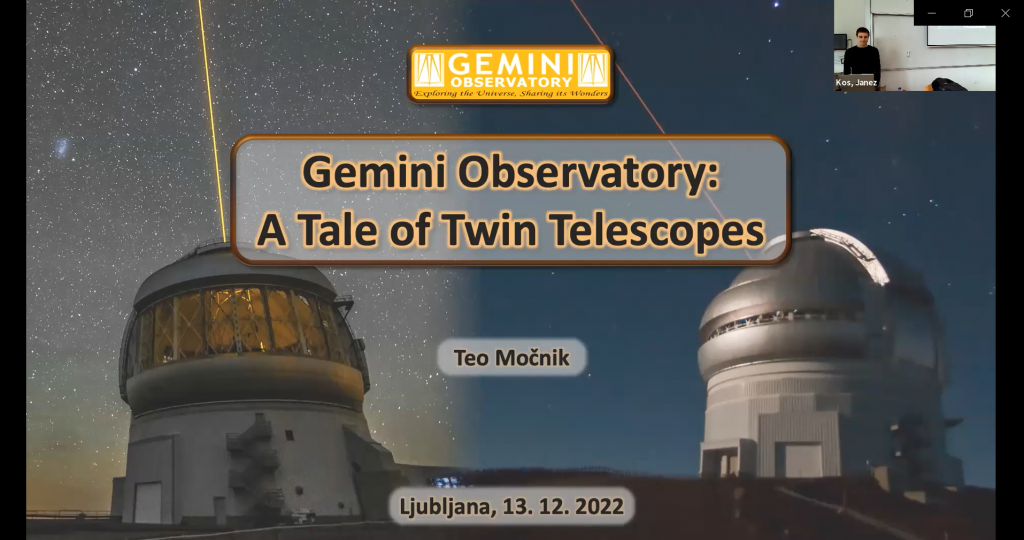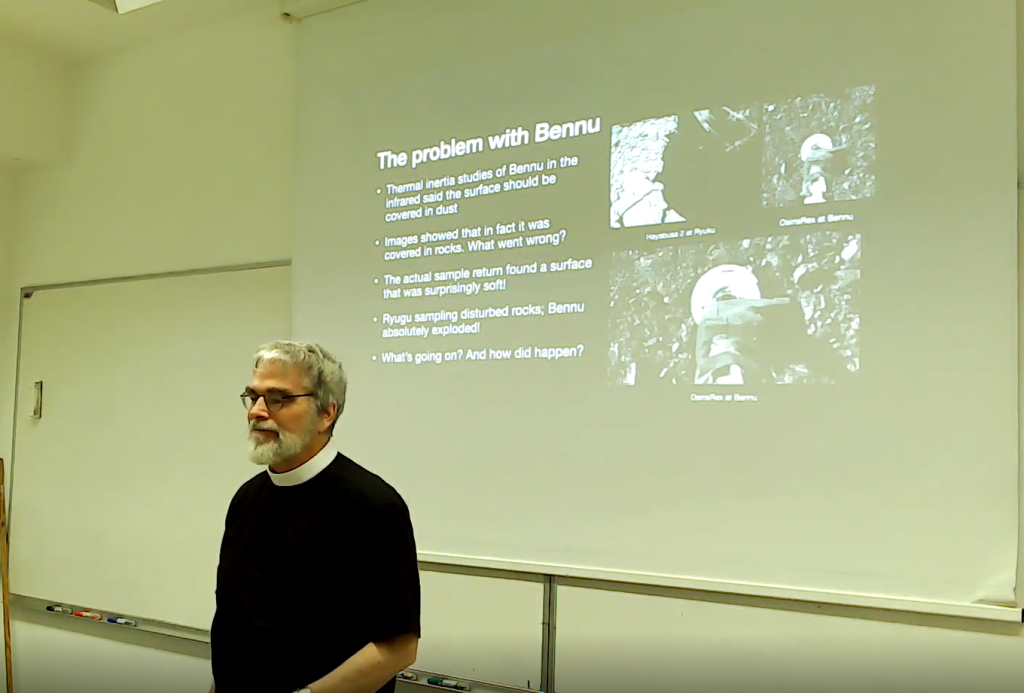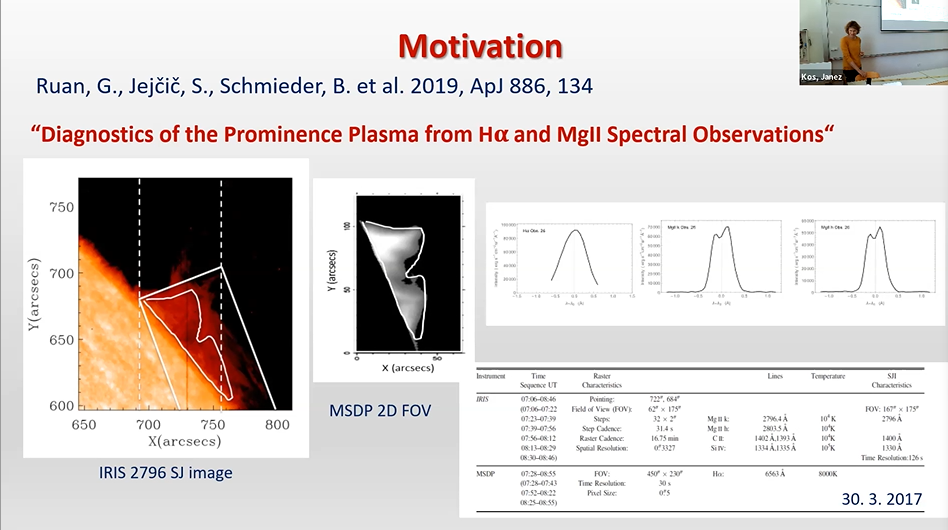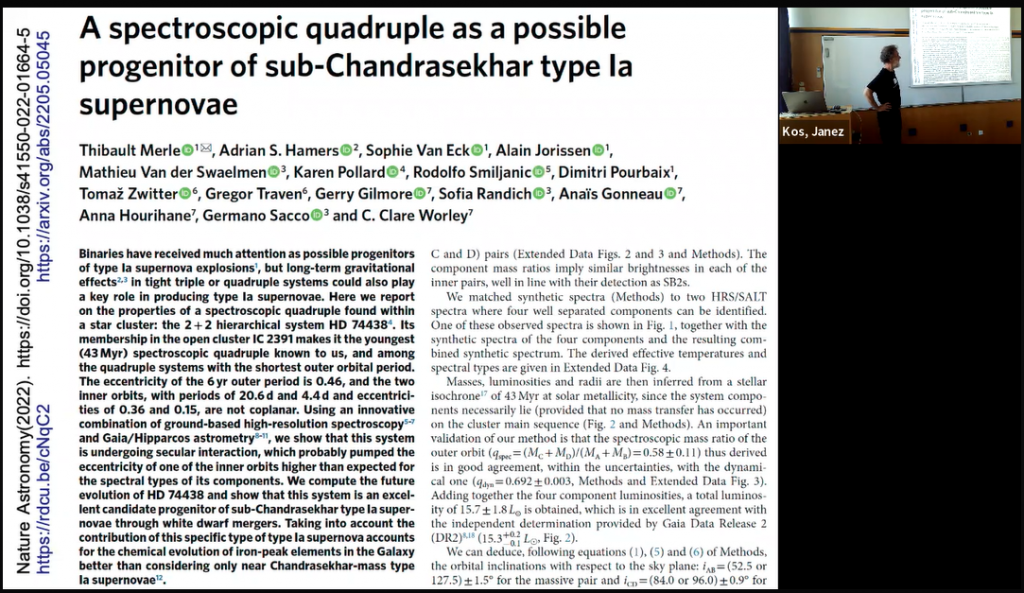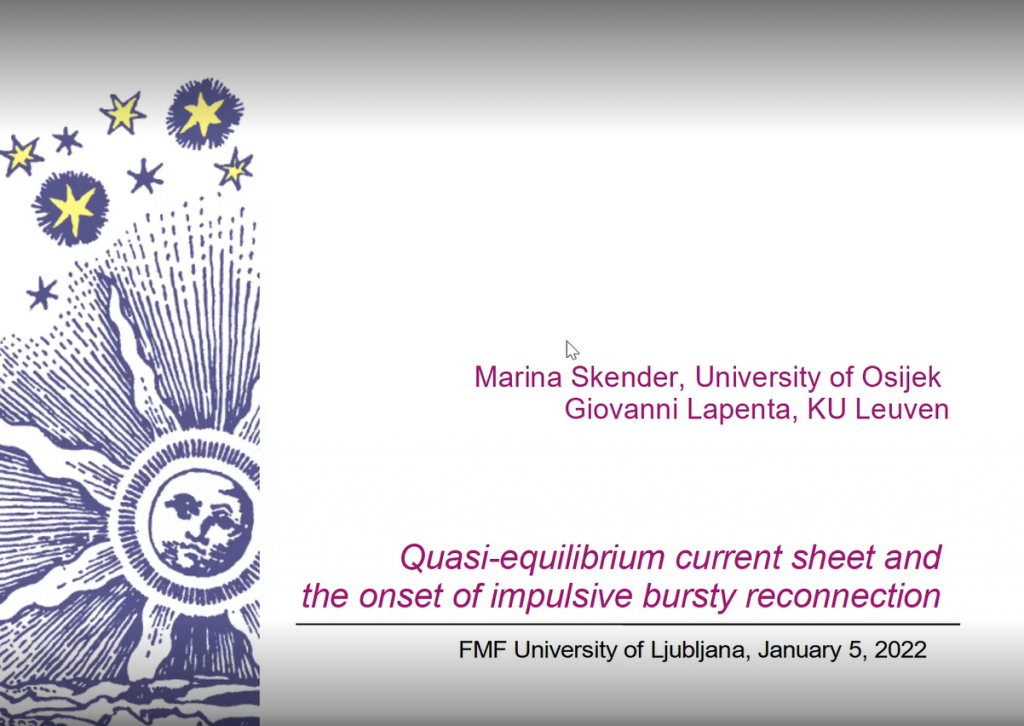Teo Močnik: Gemini Observatory: A Tale of Twin Telescopes
Teo Močnik (Gemini Telescopes)
The Gemini Observatory consists of twin 8.1 m telescopes, located on Mauna Kea in Hawaii and on the mountain of Cerro Pachon in Chile. We will virtually visit one of the telescopes and its control room, inspect our arsenal of optical and infrared instruments, take a peek at the backstage operations of the queue-based observatory, and walk through the gallery of some of our science highlights. Best of all, Slovenian astronomers can apply for Gemini observing time too!
Video: click on the image below!
Dr. Guy Consolmagno: Physical and thermal properties of asteroid-analog meteorites
dr. Guy Consolmagno, director of the Vatican Observatory
We have measured the physical properties (density, porosity, thermal properties) at low temperature for meteorites in classes closely associated with asteroids that have been sampled or are to be closely studied by spacecraft missions. Our results for CM meteorites (close analogs to asteroids Bennu and Ryugu) and iron meteorites (an important constituent of asteroid Psyche) have important applications in understanding their surface properties, including their contribution to Yarkovsky and YORP forces.
Video: click on the image below!
Kelsey Glazer: Carbon at Cosmic Dawn
24. oktober 2022
Kelsey Glazer (UC Davis)
Carbon at Cosmic Dawn is an on-going project that aims to study galaxies at the epoch of reionization. It investigates both stellar and neutral gas properties of four faint galaxies; all which are highly redshifted (z~7). We utilize ALMA and the prominent [CII] 158 μm line emission to probe these galaxies spectroscopically. In this talk I will present our preliminary results of [CII] measurements. We are able to measure [CII] line luminosities and upper limits and a velocity offset between Lyα and [CII], giving us properties of the epoch of reionization galaxies.
Sonja Jejčič: Non-LTE Inversion of Prominence Spectroscopic Observations in H alpha and Mg II h&k Lines
31. maj 2022
Quiescent solar prominences are generally assumed to have a stable large-scale structure. However, they consist of several small-scale structures that are often very dynamic. To understand the nature of prominence plasma dynamics, we analyze the plasma properties of a quiescent prominence that occurred on March 30, 2017. The prominence was simultaneously observed by several instruments, including the IRIS space-based spectrograph and the MSDP spectrograph operating at the Meudon solar tower. We focused on the IRIS Mg II h&k lines and the MSDP Hα spectra, selecting 55 well-coaligned points within the prominence. We compare the observed and synthetic profiles for all three lines using five different spectral parameters. The analysis is based on spectral inversion using an extended grid of prominence 1D slab models. The results will be presented together with 2D maps of various physical parameters, and we will discuss our best-fit solutions with respect to the radiative-equilibrium models.
Video (click on the image below)
Tomaž Zwitter: HD 74438, a quadruple star which may be on its path toward a supernova explosion
16. maj 2022
Prof. Tomaž Zwitter (UL FMF)
Binary stars are quite frequent, but we know only a handful of quadruples. In a recent paper we discuss a quadruple system composed of very young stars in tight orbits. Their mutual gravitational interactions may lead to stellar mergers resulting in a supernova explosion of type Ia. This new evolutionary channel is a promising way to form this type of supernovae which serve as standard candles for distance measurements.
Video (click on the image below)
Brian Welch: A Strongly Magnified Star and Parsec-Scale Clusters Observed in the First Billion Years
28. februar 2022
dr. Brian Welch (STScI, Baltimore)
Gravitational lensing provides a powerful tool to study distant galaxies, magnifying them to reveal small scale features that would be unresolved otherwise. Observations of galaxy clusters with the Hubble Space Telescope have used lensing to great effect, measuring high redshift galaxies at scales of tens of parsecs, as well as revealing individual stars at z ~ 1. I will present new results that further push the limits of what is possible with HST, including observations of a lensed star at z ~ 6. The star is magnified by a factor of thousands, and its observed flux is consistent with being a massive star (M > 50 M☉). The galaxy in which this star resides also contains multiple star clusters with radii < 10 parsecs, the smallest yet observed at z > 6. I will conclude with a discussion of future prospects, including planned observations with the recently launched James Webb Space Telescope.
Video (click on the image below)
Marina Skender: Evolution of quasiequilibrium current sheet
5. januar 2022
prof. Marina Skender (University of Osijek)
Magnetic reconnection is ubiquitous process in space and laboratory plasmas. A two-dimensional reconnecting current sheet is studied numerically in the MHD approach. Different simulation setups are employed in order to follow the evolution of the formed current sheet in diverse configurations: Two types of initial equilibria, Harris and force-free, two types of boundary conditions, periodic and open, with uniform and non-uniform grid set, respectively. All the simulated cases are found to exhibit qualitatively the same behaviour in which a current sheet evolves slowly through a series of quasi-equilibria; eventually it fragments and enters a phase of fast impulsive bursty reconnection. In order to gain more insight on the nature and characteristics of the instability taking place, physical characteristics of the simulated current sheet are related to its geometrical properties. The aspect ratio of the current sheet is observed to increase slowly in time up to a maximum value at which it fragments. Additional turbulence introduced to the system is shown to exhibit the same qualitative steps, but with the sooner onset of the fragmentation and at a smaller aspect ratio. Comparison with observed solar current sheets is discussed.
Video (click on the image below)
Darko Donevski: Knocking on the Doors of Dusty Giants in the Distant Universe
3. november 2020
dr. Darko Donevski, postdoctoral research fellow, SISSA
Since their initial discovery 20 years ago, the distant, dusty star-forming galaxies possess a serious challenge to the theory of galaxy formation and evolution. On one hand, these massive systems form prodigious amounts of young stars but their light is heavily absorbed by dust and re-emitted in far-infrared. On the other hand, a significant number of these dusty “Giants” have been formed in the time when the Universe was very young (e.g. < 1 billion years), questioning how such a large amount of dust has been produced so rapidly. One way of answering this question is by analysing the ratio between the dust and stellar mass in distant galaxies. In this talk, I will present how to link the state-of-the-art simulations and the observations of 300 galaxies detected with ALMA, and apply the dust-to-stellar mass ratio as a tool to understand the complex processes involved in the production of dust, metals and stars in galaxy evolution.
